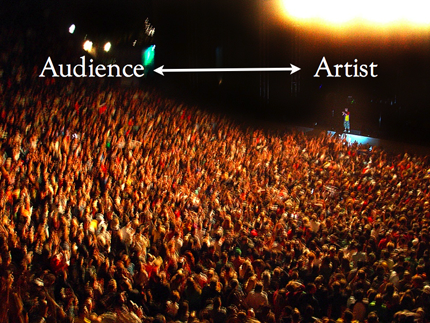Photo by michale
Conventional marketing wisdom says you should be ‘customer focused’ and do your best to satisfy consumers’ wants and needs. But it’s a different story when it comes to creative work. Many of the most successful artists achieved fame by provoking and offending public taste.
These days the Impressionists are safe choices for coffee table books and coasters, but in 1863 they had to resort to an ‘Exhibition of Rejects’ after their works were consistently refused by the major galleries in Paris. The exhibition attracted much scorn and ridicule, but gradually the public was won over and took the works to its heart.
In 1913, the first performance of Igor Stravinsky’s ballet The Rite of Spring ended in a riot. The ‘primitive’ and ‘violent’ rhythms of the music and dance shocked an audience used to a more sedate evening’s entertainment. Stravinsky left the theatre in tears – but the ballet’s impresario, Diaghilev, said the riot was “just what I wanted”.
In 1915 T.S. Eliot’s poem ‘The Love Song of J. Alfred Prufrock’ was published in the American magazine Poetry, its bold departures from the conventions of literary verse provoking outrage as well as delight. Eliot later observed that a writer must create the taste by which he is received – and proceeded to do just that in The Criterion, the literary magazine he founded and edited.
In 1985 the Jesus and Mary Chain played the North London Polytechnic. They stood with their backs to the audience and played a very short set, consisting mostly of loud guitars and piercing feedback. The inevitable riot ensued, earning them massive coverage in the music press, to the delight of their manager Alan McGhee, who had invited journalists to the gig.
All these artists show that sometimes the way to please an audience is to outrage it, gaining attention, notoriety and – later on – respect and admiration for following their own vision. On the other hand, artists (like some pop acts or Hollywood films) who are perceived as having been ‘manufactured’ to target a niche audience often fade away after an initial rush of success, as tastes move on. Audiences can show little respect for those who are too eager to please.
Audience v Artist
If we imagine a spectrum of taste, with the audience at one end and the artist at the other, we can see that the Impressionists, Stravinsky, Eliot and the Jesus and Mary Chain were firmly positioned at the ‘artist’ end of the spectrum, while Boyzone and Independence Day are nearer the ‘audience’ end.

Where you stand on this spectrum is partly a matter of instinct and partly of the creative and commercial context of your work. Playing a rock gig is very different to presenting an advertisement to a corporate client – usually, the rock stars are closer to the ‘artist’ end of the spectrum, and the ad agency is closer to the ‘audience’ end. Yet sometimes the advertising client needs to be challenged, and bands are often happy to run through old favourites to please the crowd.
When I’m writing this blog I’m fairly close to the ‘audience’ end of the spectrum – I have a fairly clear idea of the audience I’m writing for, and I don’t hit the ‘publish’ button unless I think they will find a post interesting, entertaining or useful. But when I’m writing poetry, I often take a different approach – playing a game with the reader, leaving clues and hints, to invite them to engage with the writing in a different way and come and meet me further towards the ‘artist’ end of the spectrum.
How about you?
Where do you feel you are on this spectrum? What effect does this have on the way you create and deliver your work?


IMHO, that’s why they call it ART.
Really good question Mark. One that many should consider. Not that this game is totally pure or precious or noble, but the arts have been and should be the place to humiliate yourself, to go down in flames. To rise above the common, the safe, the known. To attempt it, anyway.
Safety, security, acceptance, they can be had in many other ways.
Play to the audience and you’re dead as an artist… don’t play to the audience and you’ll starve…
It ain’t much, but it’s what we’re stuck with. And it’s a hell of a drive home.
fantastic post, mark. for both artists and audiences alike. whenever i create work, i have a bit of a mantra that is ‘know thy audience’. it doesn’t mean that i always pander to them, but that i actually try to speak to them on some level and allow a certain level of accessibility. even when you’re trying to be provocative, it certainly helps to have something that people will grasp onto.
being good at your craft, then knowing how much your audience will come with you when you push those boundaries is also vital. sow’s ear/silk purse and all that. the jesus and mary chain didn’t just succeed because they turned their backs and played with feedback – they were/are good musicians who knew how much to push and with whom – no accident that they played a poly rather than, say, royal albert hall. same with stravinsky, ts eliot and the impressionists. they were masters who knew their audience.
Thanks Robert, love the line about ‘a place to humiliate yourself’ – it seems like all the really worthwhile things in life (art, love, dancing) involve a willingness to make an utter fool of yourself if that’s the price of success. I was also thinking when I wrote the post that poetry is often criticised for being too ‘obscure’ or ‘elitist’ (usually by people who haven’t tried it recently) and there can be a certain pressure to make the work ‘accessible’. Which is fine for some poems, but not all of them.
Hey Lauren! Good to see you. And great points about knowing the audience and how far they’ll like/tolerate you pushing the boundaries. So then it becomes a dialogue between you and them, or maybe an argument or a dance?
There is a saying that goes, “Art is an expression of joy or awe.”
It doesn’t say that, “Art is an expression of joy or awe only proportional to the positive reception of its intended target audience.” 🙂
I feel that you can have both artistic expression and success. But without creation being primarily a pure expression, most people won’t be deeply interested, at least for an extended period of time.
Thanks Ben, good points. Yes you need a balance but I’d personally err on the side of expression – if you don’t have a burning desire to put something out there, the chances are no one will be much interested.
Being in a rock band I feel the need to connect with my audience. My entire night is based on my audiences reaction.
“Audiences can show little respect for those who are too eager to please.”
This remark has made me really think. I have gone from head down not giving a shit to trying way to hard to please the audience AND BOTH ARE A BAD CHOICE!
From busking on the street to playing large open air gigs I think the most important thing is that you are confident that you/your band and your music has substance and is worth contributing to the public realm.
In other words if your work is good then that’s half the battle. Blow them away with your first 3 songs, then introduce yourself show, show that you care and that you sincerily hope that they enjoy their night and feel that whatever they paid into the gig was worth it and at the same time your not going to cry yourself to sleep if the gig doesn’t go well and ‘billy folded arms’ at the front row doesn’t like your songs.
No matter how shit (you think) it’s going, remember all the work that led to the present situation of you being on stage doing what you supposedly love doing. Remember to enjoy yourself and somebody out there will connect..
…there’s nothing worse than watching a band that seem like they’re not enjoying themselves, it’s boring and it doesn’t help the audiences perception of them.
Appear to be having a good time and the audience will want in!
So to wrap up, yes give the audience what they want, to a degree…don’t take it up the arse either but to be fair they made the effort to come out and support the let’s face it…. struggling live music scene we have (at least in Ireland) today.
Philip,
21 Outs
Thanks Philip, great example. Yes, no need to take it to either extreme — the best gigs are usually the ones where there’s a bit of give and take between the band and the audience.